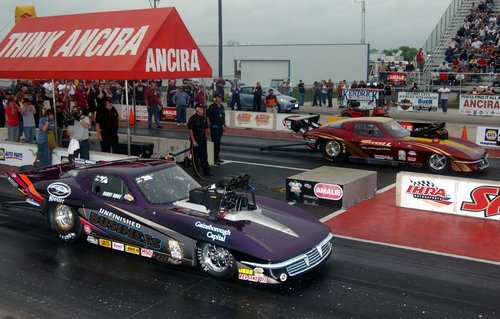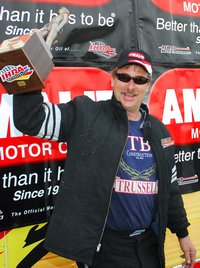HOOVER TRAVELS FULL PM CIRCLE
Ed Hoover’s experience in Pro Modified has been full circle since the category was officially launched in 1990. The class has changed a lot, but not Hoover. He’s still the hard-hitting gunner who captured the first-ever IHRA Pro Modified national event title in 1990.
Hoover became the fifth winningest driver in Pro Mod history with his recent triumph in San Antonio. He’s won twice behind the wheel of a supercharged car, and ironically both victories came at that Texas facility.
A dyed-in-the-wool nitrous racer, Hoover made the switch to a supercharged entry prior to the 2003 season. He took baby steps at first, running his new supercharged entry in the Top Sportsman division during the spring race in Rockingham.

 Ed Hoover’s experience in
Pro Modified has been full circle since the category was officially launched in
1990. The class has changed a lot, but not Hoover. He’s still the hard-hitting gunner
who captured the first-ever IHRA Pro Modified national event title in 1990.
Ed Hoover’s experience in
Pro Modified has been full circle since the category was officially launched in
1990. The class has changed a lot, but not Hoover. He’s still the hard-hitting gunner
who captured the first-ever IHRA Pro Modified national event title in 1990.
Hoover became the fifth winningest driver in Pro Mod history with his recent triumph in San Antonio. He’s won twice behind the wheel of a supercharged car, and ironically both victories came at that Texas facility.
A dyed-in-the-wool nitrous racer, Hoover made the switch to a supercharged entry prior to the 2003 season. He took baby steps at first, running his new supercharged entry in the Top Sportsman division during the spring race in Rockingham.
“It was our first time out and we were really tempted to enter it in Pro Modified, but decided to run it in Top Sportsman,” Hoover said. “We wanted to stick with the nitrous car for that weekend because it was what we knew.”
Hoover did well that weekend, but he and his crew struggled for the remainder of the season to get a handle on the supercharged combination. Lacking the experience required to devote himself totally to the blown car, the Columbia, SC-based driver for Paul Trussell alternated between the proven nitrous car and the new machine for most of the year.
In 2004, Trussell brought in noted tuner Jimmy Rector, and his addition to the roster paid immediate dividends. The team scored an IHRA Texas Nationals victory and followed it up with a runner-up finish the next weekend at the NHRA event in Houston.
THE ENSUING SEASONS
Despite his success in Texas, Hoover continued to experience inconsistent seasons. Through it all, however, he maintained a positive attitude.
“We have been fortunate to win a few times in the last few years,” said Hoover. “I am grateful for that because there are some racers who race their whole careers and never win. I can say that whether it is a headache or not, that comes with the job.”
Many would have quit after a handful of DNQs and plenty of first round loses, but Hoover and Trussell never gave it a thought.
“Never.” Hoover said. “I have been kicked around all of my life in business deals and in drag racing. What you have to do is get up every morning with the state of mind that you are going to beat this thing today.”
Their largest enemy proved to be continual rule changes in mid-season.
“We’ve been up and down with it,” Hoover said. “Every time we got a handle on it, the rules changed. We bought a supercharged motor from Mike Janis when we first got started and it took two rule hits before we even got it in the car.
“We got a handle on it two years ago and ran a 6.16 and made it to the semifinals,” Hoover said. “Then they changed the rules again. We weren’t that experienced on the blower combination to be able to compensate for the changes.
“We ran a 6.07 last fall and made our way back into the thick of things – we were finding our horsepower. Then they changed the rules over the winter. We are almost back to where we were last year with horsepower.”
Rule change or no rule change, Hoover and Trussell made wholesale changes to their team and the end result has been a rise to the top of the Torco’s CompetitionPlus Pro Modified division. They purchased a new ’63 Corvette from G-Force Race Cars, and brought in noted tuner Al Billes to assist with the tuning calls.
“We have almost 300 more horsepower than we did last year, but the new rear gear rule takes it away,” Hoover said. “It doesn’t accelerate as hard.”
ON THE OTHER SIDE OF THE FENCE
Through it all, Hoover admitted there’s a lot more to running the combination that just strapping on a supercharger and going quick. That was a common phrase used amongst the nitrous racers in the early years of the class in their parity arguments.
“It wasn’t easy, I’ll admit that,” Hoover said. “You have to take into consideration that they’ve cut these blowers back … put weight in them … taken rear gear out. We would have been dangerous with a 4.77 gear and 35 or 40-percent over like they were running them back then. That’s an animal compared to what we have now.
“None of this is easy. Power is your best friend until you have to get a car down a slick race track. Then it is a nightmare. You wish for horsepower throughout your career and once you get it in a situation like this, you don’t know what to do with it. It’s tricky to manage but you have to have it.”
Hoover was once on the side lobbying for rule changes and now he can’t help but feel a bit of the “what comes around goes around” syndrome.
“Yeah, I felt a bit of that but we weren’t the only ones changing,” Hoover said. “The nitrous guys had to change some things or the Pro Stockers would have caught us. If we hadn’t done something, the Pro Stockers would have been ahead of us. The class has got to get quicker each year. If not it is going to get stale.”
A DIFFERENT KIND OF PRO MODIFIED
The class has changed a lot since Hoover won the 1990 IHRA Winter Nationals in Darlington, S.C., yet some things remain the same. A once affordable class is now a lot more expensive, yet hard work is still what turns on the win-light.
“You have to make rounds … each and every race and qualifying remains an important part of the mix,” said Hoover. “There are a lot of people spending a lot of money in the class. Back when I started, you used to do it all and serve as your own crew chief. Now you have to have a crew chief. There are a lot of new cars and equipment. Money is no object. It’s going to be a tough year. The stress level is going to be high this year.”
Hoover says one had better bring their best game to the table and that more times than not will require a five-second run. He’s not scared to go that quick, but he is concerned with the safety aspects.
“I would love to see them go into the five-second zone but then again we have to consider the safety factor,” Hoover said. “I am not an engineer but I really don’t believe there’s much difference in crashing in the 5.90s and the 6.0s. The chassis is basically the same as we had when Paul and I started together and the cars were running 6.60s. When you pick up almost three-quarters of a second, you need to look at the safety of the chassis configuration.
“I feel really safe in this car. We could take the weight out and I will go 5.80s with no fear. I just want to be extra careful and make sure that none of my friends and fellow racers get hurt.”
“I think the class needs to separate itself more from the Pro Stockers. Maybe if this nitrous combination takes off, they can take 50 pounds off of us. I’m dreaming, though.”




































